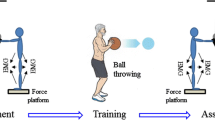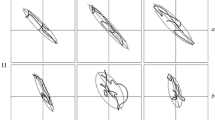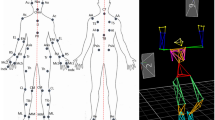Abstract
Physiological parameters of hitting the ball in the unsupported position and prospects for improving spikes through training with a biological feedback were studied in volleyball players. The physiological and biomechanical parameters characterizing a direct attacking shot in a supported position correlate with the biomechanical specificities characterizing the performance of this short in a jump. At the same time, the physiological ability to provide the accuracy of hitting actions is associated, first, with improving the coordination of trunk and arm movements in the flight phase, second, with the factors of intramuscular and intermuscular coordination of the striking arm, and, third, with a change in the pattern of motions of an athlete’s center of pressure. The use of a computer-based stabilographic method of training with a biofeedback contributes to the optimization of physiological and biomechanical parameters of motor actions in the unsupported position, which results in an increased accuracy of hitting the ball in a jump. The obtained results open prospects for applying the method of computer-based stabilography for improving the performance skill of accuracy- and target-oriented actions in unsupported positions in various kinds of sports.
Similar content being viewed by others
References
Malakhov, M.V., Makarenkova, E.A., Mel’nikov, A.A., and Vikulov, A.D., Assessment of influence of breath holding and hyperventilation on human postural stability with spectral analysis of stabilographic signal, Hum. Physiol., 2014, vol. 40, no. 1 p. 77.
Tomasino, B., Guatto, E., Rumiati, R., et al., The role of volleyball expertise in motor simulation, Acta Psychol., 2012, vol. 139, no. 1 p. 1.
Burk, J.M., Munkasy, B.A., Joyner, A.B., et al., Balance error scoring system performance changes after a competitive athletic season, Clin. J. Sport Med., 2013, vol. 23, no. 4 p. 312.
Ozer, D., Duzgun, I., Baltaci, G., et al., The effects of rope or weighted rope jump training on strength, coordination, and proprioception in adolescent female volleyball players, J. Sports Med. Phys. Fitness, 2011, vol. 51, no. 2 p. 211.
Pau, M., Loi, A., Pezzotta, M., and Cristina, D., Sensorimotor training improve the static balance of young volleyball players? Sports Biomech., 2012, vol. 11, no. 1 p. 97.
Krivsun, S.N., Sport myography concepts, Teor. Prakt. Fiz. Kul’t., 2012, no. 9, p. 46.
Nikolaidis, P.T., Ziv, G., Arnon, M., et al., Physical characteristics and physiological attributes of female volleyball players—the need for individual data, J. Strength Cond. Res., 2012, vol. 26, no. 9 p. 2547.
Noyes, F.R., Barber-Westin, S.D., Smith, S.T., et al., A training program to improve neuromuscular indices in female high school volleyball players, J. Strength Cond. Res., 2011, vol. 25, no. 8 p. 2151.
Afonso, J., Garganta, J., Mcrobert, A., et al., Visual search behaviours and verbal reports during film-based and in situ representative tasks in volleyball, Eur. J. Sport Sci., 2014, vol. 14, no. 2 p. 177.
Borras, X., Balius, X., Drobnic, F., et al., Vertical jump assessment on volleyball: a follow-up of three seasons of a high-level volleyball team, J. Strength Cond. Res., 2011, vol. 25, no. 6 p. 1686.
Sattler, T., Sekulic, D., Hadzic, V., et al., Vertical jumping tests in volleyball: significance, validity, and playing-position specifics, J. Strength Cond. Res., 2012, vol. 26, no. 6 p. 1532.
Wagner, H., Pfusterschmied, J., Tilp, M., et al., Upperbody kinematics in team-handball throw, tennis serve, and volleyball spike, Scand. J. Med. Sci. Sports, 2014, vol. 24, no. 2 p. 345.
Gil, A., Perla, M.M., Moreno, A., et al., Analysis of the relationship between the amount of training and cognitive expertise. A study of young volleyball players, J. Strength Cond. Res., 2013, vol. 27, no. 3 p. 698.
Sekulic, D., Spasic, M., Mirkov, D., et al., Genderspecific influences of balance, speed, and power on agility performance, J. Strength Cond. Res., 2013, vol. 27, no. 3 p. 802.
Lyakh, V.I., Koordinatsionnye sposobnosti: diagnostika i razvitie (Coordination Capacities: Diagnostics and Development), Moscow: TVT Divizion, 2006.
Nunes, G.S., de Noronha, M., Cunha, H.S., et al., Effect of kinesio taping on jumping and balance in athletes: a crossover randomized controlled trial, J. Strength Cond. Res., 2013, vol. 27, no. 11 p. 3183.
Pietraszewski, B. and Struzik, A., Evaluation of selected biomechanical parameters in female team sports players, Acta Bioeng. Biomech., 2013, vol. 15, no. 4 p. 103.
Kruse, N.T., Barr, M.W., Gilders, R.M., et al., Using a practical approach for determining the most effective stretching strategy in female college division I volleyball players, J. Strength Cond. Res., 2013, vol. 27, no. 11 p. 3060.
Buravel’, O.I., Koshel’skaya, E.V., Kapilevich, L.V., et al., Physiological and biomechanical characteristics of the technique of the shot-target actions of soccer players, Byull. Eksp. Biol. Med., 2012, vol. 153, no. 2 p. 235.
Tomasino, B., Maieron, M., Guatto, E., et al., How are the motor system activity and functional connectivity between the cognitive and sensorimotor systems modulated by athletic expertise?, Brain Res., 2013, vol. 1540, p. 21.
Sharma, A., Geovinson, S.G., and Sandhu, J.S., Effects of a nine-week core strengthening exercise program on vertical jump performances and static balance in volleyball players with trunk instability, J. Sports Med. Phys. Fitness, 2012, vol. 52, no. 6 p. 606.
Voelzke, M., Stutzig, N., Thorhauer, H.A., et al., Promoting lower extremity strength in elite volleyball players: Effects of two combined training methods, J. Sci. Med. Sport, 2012, vol. 15, no. 5 p. 457.
Trajkovic, N., Milanovic, Z., Sporis, G., et al., The effects of 6 weeks of preseason skill-based conditioning on physical performance in male volleyball players, J. Strength Cond. Res., 2012, vol. 26, no. 6 p. 1475.
Soroko, S.I. and Trubachev, V.V., Neirofiziologicheskie i psikhofiziologicheskie osnovy adaptivnogo bioupravleniya (Neurophysiological and Psychophysiological Foundations of Adaptive Biomanagement), St. Petersburg: Politekhnika-servis, 2010.
Kapilevich, L.V., Physiological mechanisms of movement coordination in the unsupported position in athletes, Teor. Prakt. Fiz. Kul’t., 2012, no. 7, p. 45.
Bernshtein, N.A., Fiziologiya dvizhenii i aktivnost’ (Physiology of Movement and Activity), Moscow: Nauka, 1990.
Gagey, P. M. and Weber, B., Posturologie: Regulation et dereglements de la station debout, Paris: Masson, 1995 (Russian version, St. Petersburg, 2008).
Gurfinkel’, V.S. and Levik, Yu.S., System of internal representation and movement control, Vestn. Ross. Akad. Nauk, 1995, vol. 65, p. 29.
Bocharov, M.I., Chastnaya biomekhanika s fiziologiei dvizheniya (Particular Biomechanics with the Physiology of Movement), Ukhta: UGTU, 2010.
Author information
Authors and Affiliations
Corresponding author
Additional information
Original Russian Text © L.V. Kapilevich, E.V. Koshelskaya, S.G. Krivoschekov, 2015, published in Fiziologiya Cheloveka, 2015, Vol. 41, No. 4, pp. 73–81.
Rights and permissions
About this article
Cite this article
Kapilevich, L.V., Koshelskaya, E.V. & Krivoschekov, S.G. Physiological basis of the improvement of movement accuracy on the basis of stabilographic training with biological feedback. Hum Physiol 41, 404–411 (2015). https://doi.org/10.1134/S036211971504009X
Received:
Published:
Issue Date:
DOI: https://doi.org/10.1134/S036211971504009X




